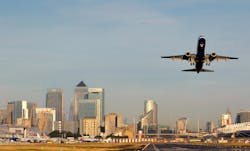London City is the first major airport to control air traffic via a digital tower
HAMPSHIRE, U.K., - Tech is firmly ingrained in air travel. From biometric boarding gates to parallel reality displays that beam custom messages, the process of catching a flight has changed dramatically in the past couple of decades. Now, a major technological breakthrough has been announced in the operation and management of air travel. London City Airport has hailed itself as the world's first major international airport to be able to fully control air traffic using a digital tower, Saqib Shah reports for Engaget. Continue reading original article.
The Intelligent Aerospace take:
May 3, 2021 - "We are immensely proud to become the first major international airport to adopt this pioneering technology," said Alison Fitzgerald, Chief Operating Officer at London City Airport. "This investment in smart infrastructure will help us meet future growth in passenger demand, improve air traffic management and give us enhanced capability as aviation bounces back from the pandemic. It is also a demonstration of the commitment to innovation in the UK aviation sector and to being at the forefront of defining the future of flight. Since going operational at the end of January, the technology has worked really well and is ready for the expected increase in demand for flights as Brits book their well-deserved summer getaways."
Sixteen high-definition cameras and sensors mounted on the mast capture a 360-degree view of the City Airport airfield. This is relayed through super-fast fiber connections to a new control room in NATS’ air traffic control center in Swanwick. A dedicated team of controllers use the live footage, an audio feed from the airfield and radar information to instruct aircraft movements in and out of the airport.
The live feed, transmitted through independent secure fiber networks, is displayed on 14 HD screens in the Swanwick control room to provide a panoramic moving image. This can be overlaid with digital data to provide an ‘enhanced reality’ view.
Information such as call signs, altitude and speed of all aircraft approaching and leaving the airport, weather readings and the ability to track moving objects can all be included in this single visual display. Pan-tilt-zoom cameras can magnify images up to 30 times for close inspection.
